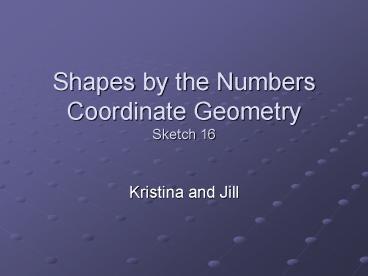Shapes by the Numbers Coordinate Geometry Sketch 16 PowerPoint PPT Presentation
Title: Shapes by the Numbers Coordinate Geometry Sketch 16
1
Shapes by the NumbersCoordinate GeometrySketch
16
- Kristina and Jill
2
Overview of contributions
- Ancient times
- Early mathematicians (16th century and earlier)
- Menaechmus
- Apollonius
- Francois Viete
- Major Contributors
- Descartes
- Fermat
3
Ancient Times
- Uses
- Egypt
- Rectangular grid
- Rome
- Surveyors
- Greece
- Mapmakers
4
Early Mathematicians
- Menaechmus
- Introductions of Conic Sections
- Apollonius
- Work related to loci
- Made a start in the development of analytic
geometry - Related geometric figures to ratios and words
- Francois Viete
- Took a leap on focusing algebra to geometric
problems
5
Fermat
- Study works of Apollonius and Viete
- He wrote a manuscript entitle Introduction to
Plane and Solid Loci - Developed a unique coordinate system
- His development of locus to equation
- Represented curves using algebra in two variables
- Parabola x2dy
- Hyperbola b2x2ay2
- Circle b2-x2y2
- Ellipse b2-x2ay2
- Straight line x2xyay2
- Only considered positive values
- His contributions were not published until after
his death so a lot of credit was given to
Descartes.
6
Descartes
- Influenced by Viete and Islamic mathematicians
- Published Discourse on the Method of Rightly
Conducting the Reason in the Search for Truth in
the Sciences - La Geometrie is the section in which his work on
analytic geometry appears. - Used single horizontal axis
- Introduced what we now know as x and y
- Represented unknowns using the letters at the end
of alphabet and constants using letters at the
beginning of the alphabet - Demonstrated how algebraic equations are formed
using their solutions
7
Others that followed
- Frans van Schooten
- Translated Descartes work into Latin and added
missing detail - John Wallis
- Extended analytic geometry ideas to include
negatives - Jan de Witt
- Details on how to solve the locus problem for
quadratic equations - Isaac Newton
- Learned about analytic geometry on his while
developing ideas of Calculus
8
Compare and Contrast
- Fermat
- Described curve from an equation
- Used a single axis (horizontal)
- Never published his work
- Descartes
- Described algebraic equation from a curve
- Used a single axis (horizontal)
- Published his work but in French with omitted
detail - Dealt with more complex equations than Fermat did
9
History of Geometry and Algebra
- Algebra grew out of simple manipulation of
geometric shapes - During the medieval period and Renaissance
algebra was freed from Geometry - Algebra and Geometry returned to one another in
what we now know as analytic geometry
10
Timeline
- Ancient Egypt used rectangular grid
- Same method used by Roman Surveyors and Greek
mapmakers - 350 B.C. Menaechmus introduces conic sections
- Approximately 250 B.C. Apollonius works on loci
of curves - Late 16th Century Francois Viete worked on using
algebra in geometric problems
11
Timeline Continued
- Early 17th Century Fermat and Descartes
introduced work on analytic geometry - 1649-1693 Van Schooten translated La Geometrie
into Latin and added omitted detail - Approximately 1659 Jan de Witt provided details
to solve locus problems of quadratic equations - End of the 17th Century analytic geometry was
widely known throughout Europe
12
Resources
- Berlinghoff, William P., and Fernando Q. Gouvea.
Math Through the Ages a Gentle History for
Teachers and Others. Farmington, Maine Oxton
House, 2002. 135-140. - Katz, Victor J. A History of Mathematics. New
York Pearson, 2004. 260-270. - "Analytic Geometry Marriage of Algebra
Geometry." Think Quest. 2001. 14 Nov. 2006
lthttp//library.thinkquest.org/C0110248/geometry/h
istory5.htmgt. - Gale, Thomas. "The Development of Analytic
Geometry." Book Rags. 2006. Science and Its
Times. 14 Nov. 2006 lthttp//www.bookrags.com/resea
rch/the-development-of-analytic-geometr-scit-03123
/gt.

